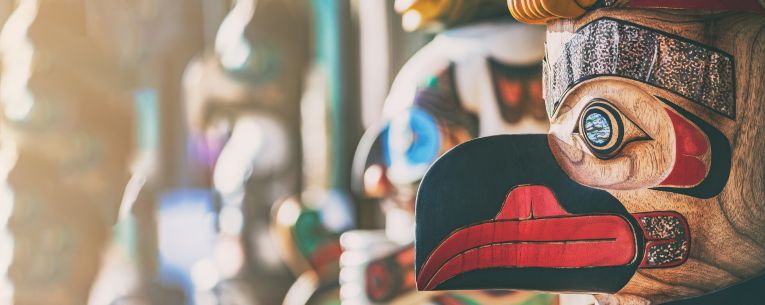Throughout the Americas, there are numerous historically and environmentally significant destinations that are important to Indigenous peoples. While traveling to these destinations, you should strive to recognize the impact of Native cultures and history, and avoid perpetuating the marginalization caused by colonization and discrimination.
Here are ideas on how to practice ethical tourism to respect Indigenous peoples by learning about the past, visiting and caring for natural areas, and supporting Indigenous economies.
First — learn about where you live
It’s important to remember that all U.S. lands were first inhabited by Native Americans, including where you live. Pull up the online Native Land map to learn the indigenous history of your city or county, recommends an article on Indigenous tourism in AFAR.
Understanding the history of the land under your shoes goes a long way toward considering how Indigenous peoples are continuing to shape the U.S., says Jolie Varela, founder of Indigenous Women Hike, an initiative that reconnects Native people with natural areas.
“Once you learn about Indigenous histories and think and think about Indigenous futures in places, it really starts to change the way you see them,” Varela says in AFAR. “And once they [travelers] learn that history, I think it opens a whole door for them. And then it just leads to being more mindful.”
Research before your next journey
Road trips are a fun and iconic way to see the sights in small towns and big cities in the U.S. While you’re excitedly researching stops or the final destination for your next road trip, you should include Native landmarks in your plans. If you’re outdoorsy and love to hike, bike or kayak, consider visiting blueways and greenways that were first traveled by Native Americans, and learning the often overlooked history of these routes.
The BBC reports that many of the trails we traverse today, “were originally forged by Indigenous hunters and traders centuries earlier.”
Once such famed route is the John Muir Trail, named for the American conservationist. While the trail shares Muir’s name, it predates him as a centuries-old trade route used by tribes in the Sierra known as the Nüümü Poyo, or the People’s Trail.
On the East Coast, the Appalachian Trail is rich with Native history. One such site is where the trail passes through Blood Mountain Georgia, near where a Cherokee Nation community was forcibly removed by the U.S. government on the Trail of Tears in 1838. Here’s a great resource for more indigenous history along the A.T.
Some of these originally Native trails are part of lands stolen by the U.S. government to build roads and railways. In recent years tribes, state governments and organizations have worked to reclaim these Indigenous tracks as hiking and biking routes, the BBC reports.
The 135-mile Olympic Discovery Trail, which takes hikers past gorgeous peaks and glacial lakes, was built on a former railroad that originally was a path that connected tribal villages. If you’re ever hiking the trail, stop at the nearby Jamestown S'Klallam Tribal Library, which houses books by Indigenous authors. View or buy the work of indigenous artists at the Native Art Gallery. The environmentally minded should also visit Dungeness River Nature Center, which educates tourists about the efforts of the Jamestown S’Klallam Tribe to restore salmon habitat along the Olympic Discovery Trail, and the significance of the Dungeness River to the tribe.
In Nebraska, the 22-mile Chief Standing Bear Trail traces Indigenous hunting and trading routes and marks the start of where the Ponca were forcibly removed. The trail is owned by the Ponca Tribe of Nebraska and educational signage along the route explains its significance.
Support Native-owned tours and businesses
The best way to learn about Indigenous cultures is from an Indigenous guide, says Sherry L. Rupert, CEO of the American Indian Alaska Native Tourism Association in AFAR.
“Whether you visit a national park, an urban setting, a beach, or anywhere in between, that land once belonged to an Indigenous community,” Rupert says. “Learning more about Native Nations and communities from someone with family ties that date back generations provides you with a new travel lens while giving you a deeper understanding of the American experience.”
Go to your preferred online search engine to see if there are Indigenous cultural centers along your road trip route. These places can connect you to experts and other resources. The database NativeAmerican.Travel has information on tourism opportunities run by Indigenous people.
An incredible hands-on tour is a three-hour Appaloosa Horse Riding Session by Nez Perce Tourism. Participants learn about the meaningful connection between the Appaloosa horse and the Nez Perce people. Wranglers who are Native lead Appaloosa rides and guides teach history at Nez Perce National Historical Park.
Practice "Leave No Trace" and pay a land tax
The biggest takeaway from this article should be to always honor the land. Tourists should respect wild areas and their connection to native cultures, says Varela in AFAR.
“The middle of nowhere, as people like to use that phrase, is still the center of one Nation’s universe—our creation stories, where we’re from,” she says.
When visiting wild and sacred spaces, don’t disturb petroglyphs and other artifacts, or animals and plants. Remove trash you spot on the trail and stay on the trail, so as not to cause erosion or crush vegetation. Don’t stand on natural arches, which causes structural wear over time.
Pay a Land Tax to Native organizations who are stewards of natural areas, and whose land was seized to make way for today’s cities. “Land Taxes are a form of reparation, a recognition that the debts owed to Native people have not been paid,” writes AFAR.
One example is Real Rent Duwamish, which calls on people living in the city of Seattle to pay a land tax. Visitors of the city should also consider paying the tax. Funds go toward Duwamish Tribal Services, which revives and promotes Duwamish culture. Though the city of Seattle was named for Duwamish leader Chief Seattle, “The tribe has yet to be justly compensated for their land, resources, and livelihood,” writes Real Rent Duwamish.
“You should be uplifting and giving monetary donations to the First People who have always cared for that land so that you can come and visit it and see what it is today,” says Varela. “Without us, it would be a whole different story.”
Before you hop in your car, or after you book a plane ticket on your journey to learn more about Native peoples, you should consider purchasing travel insurance. An Allianz Travel Insurance plan with Trip Cancellation benefits can reimburse certain non-refundable expenses if your trip is canceled or delayed for a covered reason, whether you drive or fly. Certain travel insurance plans also offer Emergency Medical benefits, Baggage Loss/Delay benefits, and rental car protection.
As a world leader in travel protection, we help millions of travelers answer the call of adventure with confidence every year. Let us be there for you too.
Related Articles








Share this Page